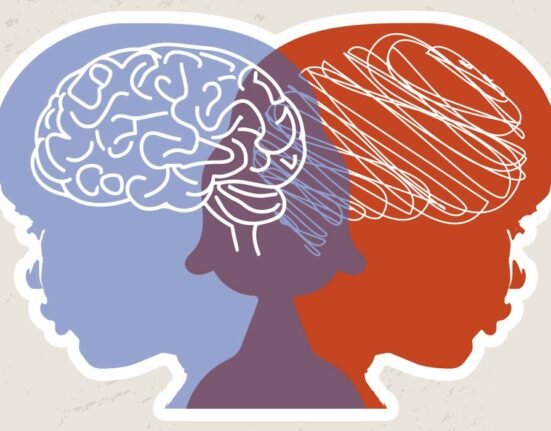Life doesn’t pitch curveballs. It uses sledgehammers. And what happens when the weight of everything, fear, anguish, and noise, crushes down? Your mind does what trapped things do: It flees. It’s as if you’re in your body but not truly present. It’s like witnessing your own life through thick, twisted glass. Memories you know should be yours? Gone. Vanished mid-sentence. You catch your reflection and flinch—Who’s that? The eyes staring back feel borrowed. The world goes muffled. Distant. Like you’re underwater. You’re here. But you’re not here. That’s dissociation. It’s not a choice. It’s your mind’s survival reflex—a desperate, last-ditch shelter when reality feels like a warzone.
For some, this becomes a prison they can’t escape. The disconnection lingers. Memories fracture. Identities split. The ground beneath them never feels solid. That’s a dissociative disorder. It’s rare. It’s widely misunderstood. But for those living it? It’s not just “feeling spaced out.” It’s fighting to feel real.
Read More: Dissociative Disorders: An Overview
The Survival Algorithm Nobody Talks About
We’ve all had those mild dissociation moments—highway hypnosis where you arrive home without remembering the drive, or getting so lost in a daydream you tune out the world. That’s normal (Hunter et al., 2003). What we’re talking about here is different. This is your brain’s emergency override system. When trauma hits—especially repeated childhood trauma where escape is impossible—the mind makes a calculation: “How do I survive this?” The answer: “Compartmentalise. Wall off the unbearable. Create separate mental spaces where the pain can be contained” (Klulf, 1984; Ross, 1989).
The result? Instead of one continuous consciousness, you get fragments. Parts that hold different memories, different emotions, different ways of being (Van der Hart et al., 2006). For some, this means:
The Shattered Mirror (What Some Call DID)
This isn’t multiple personalities. This is one personality that had to fracture to survive (International Society for the Study of Trauma and Dissociation, 2011). Different self-states emerge, each holding pieces of the whole story. The brain literally functions differently in these states—heart rate changes, vision sharpens or dulls, even allergies can appear or disappear (Putnam et al., 1990; Braun, 1983). The most telling sign? Lost time. Gaps in your story where life should be (Steinberg et al., 1993).
The Vanishing Act (Dissociative Amnesia)
This is the mind’s targeted deletion service. Not “I can’t remember,” but “this memory has been surgically removed to protect the system.” It might be a specific event, or in rare cases, entire chunks of one’s past (American Psychiatric Association, 2013). The memory exists—it’s just behind a firewall the conscious mind can’t access (Kihlstrom, 2005).
The Glass Wall (Depersonalization/Derealization)
This is the mind creating distance instead of fragments. You feel like you’re watching your life from outside your body. The world seems fake, dreamlike, two-dimensional (Simeon & Abugel, 2006). The cruel twist? You know it’s not real. This awareness creates a special kind of hell—being trapped in your own head, screaming silently while everything feels unreal (Sierra & Berrios, 1998).
Read More: Depersonalization-Derealization Disorder: Symptoms and Treatment
Your Nervous System’s Betrayal Becomes Its Strategy
Here’s what the dry research papers don’t tell you: this isn’t psychological. It’s physiological. Trauma doesn’t just live in your mind—it gets etched into your body (Van der Kolk, 2014). When trauma hits, especially in childhood, the nervous system rewires itself (Perry, 2009). The brain’s alarm system gets stuck on high alert (Lanius et al., 2010). The thinking prefrontal cortex goes into overdrive to suppress emotional tsunamis (Frewen & Lanius, 2006). The memory centres struggle to process traumatic memories normally (Brewin et al., 2010). Your body learns: dissociation equals survival. The strategy that saved you during trauma becomes the prison that confines you afterwards (Nijenhuis et al., 2002).
Read More: How Does Trauma Affect Brain Function?
The Long Road Back to Yourself
Healing from this isn’t about “fixing” what’s broken. It’s about welcoming home the parts of yourself that had to leave to survive. There’s no quick fix. No magic pill. Recovery moves through phases (International Society for the Study of Trauma and Dissociation, 2011): First, you learn safety. How to stay in your body when everything screams to escape. Grounding techniques. Breathing. Simple things like feeling your feet on the floor or your hands in water (Ogden et al., 2006). This isn’t fluffy self-help—this is neural retraining.
Then, slowly, carefully, you begin the work of integration. Not “getting rid of parts,” but helping them communicate (Watkins & Watkins, 1997). Helping the warrior who protected you learn to stand down. Helping the fragments remember they belong to the same whole. Therapies that help aren’t about talking—they’re about experiencing. Somatic approaches that help the body release what it’s been holding (Levine, 1997). Techniques that help reprocess traumatic memories so they lose their power (Shapiro, 2001; Van der Kolk et al., 2007). This work takes courage that most people will never understand. It’s showing up day after day to face the very things your mind worked so hard to protect you from.
Read More: How Bad Memories Can Affect Our Intelligence: Exploring the Psychological Impact
The Unspoken Truth
Dissociative disorders aren’t disorders of weakness. They’re testaments to incredible strength. They represent a mind’s fierce, brilliant determination to survive at all costs (Howell, 2005). The very strategies that saved you then may imprison you now. But the mind that found a way to survive trauma can find a way to heal from it. The ghosts in your machine aren’t enemies—they’re protectors who need to learn their services are no longer required. The war is over. The emergency has passed. Slowly, gently, the fragments can begin to remember they belong to each other.
Healing doesn’t mean becoming someone new. It means coming home to who you always were—the self that had to scatter to survive, now slowly, tenderly, gathering itself back together. The fog lifts. The glass wall cracks. The ghost remembers how to inhabit its body. Piece by piece, you come back to yourself. Not the self you were before—that person is gone. But someone wiser, stronger, and more whole than you ever thought possible. The mind that fractured to save you can integrate to heal you. The same brilliance that built the walls can learn to take them down.
References +
American Psychiatric Association. (2013). Diagnostic and statistical manual of mental disorders (5th ed.). American Psychiatric Publishing.
Braun, B. G. (1983). Psychophysiologic phenomena in multiple personality and hypnosis. American Journal of Clinical Hypnosis, 26(2), 124-137.
Brewin, C. R., Gregory, J. D., Lipton, M., & Burgess, N. (2010). Intrusive images in psychological disorders: Characteristics, neural mechanisms, and treatment implications. Psychological Review, 117(1), 210-232.
Frewen, P. A., & Lanius, R. A. (2006). Toward a psychobiology of posttraumatic self dysregulation: Reexperiencing, hyperarousal, dissociation, and emotional numbing. Annals of the New York Academy of Sciences, 1071(1), 110-124.
Howell, E. F. (2005). The dissociative mind. Routledge.
Hunter, E. C., Phillips, M. L., Chalder, T., Sierra, M., & David, A. S. (2003). Depersonalisation disorder: A cognitive-behavioural conceptualisation. Behaviour Research and Therapy, 41(12), 1451- 1467.
International Society for the Study of Trauma and Dissociation. (2011). Guidelines for treating dissociative identity disorder in adults, third revision. Journal of Trauma & Dissociation, 12(2), 115- 187.
Kihlstrom, J. F. (2005). Dissociative disorders. Annual Review of Clinical Psychology, 1, 227-253.
KluŌ, R. P. (1984). Treatment of multiple personality disorder: A study of 33 cases. Psychiatric Clinics of North America, 7(1), 9-29.
Lanius, R. A., Vermetten, E., Loewenstein, R. J., Brand, B., Schmahl, C., Bremner, J. D., & Spiegel, D. (2010). Emotion modulation in PTSD: Clinical and neurobiological evidence for a dissociative subtype. American Journal of Psychiatry, 167(6), 640-647.
Levine, P. A. (1997). Waking the tiger: Healing trauma. North Atlantic Books.
Nijenhuis, E. R., Van der Hart, O., & Steele, K. (2002). The emerging psychobiology of trauma-related dissociation and dissociative disorders. Psychiatric Clinics of North America, 25(2), 365-396.
Ogden, P., Minton, K., & Pain, C. (2006). Trauma and the body: A sensorimotor approach to psychotherapy. W. W. Norton & Company.
Perry, B. D. (2009). Examining child maltreatment through a neurodevelopmental lens: Clinical applications of the neurosequential model of therapeutics. Journal of Loss and Trauma, 14(4), 240- 255.
Putnam, F. W. (1989). Diagnosis and treatment of multiple personality disorder. Guilford Press.
Putnam, F. W., Zahn, T. P., & Post, R. M. (1990). Differential autonomic nervous system activity in multiple personality disorder. Psychiatry Research, 31(3), 251-260.
Ross, C. A. (1989). Multiple personality disorder: Diagnosis, clinical features, and treatment. John Wiley & Sons.
Shapiro, F. (2001). Eye movement desensitisation and reprocessing (EMDR): Basic principles, protocols, and procedures (2nd ed.). Guilford Press.
Sierra, M., & Berrios, G. E. (1998). Depersonalization: Neurobiological perspectives. Biological Psychiatry, 44(9), 898-908.
Simeon, D., & Abugel, J. (2006). Feeling unreal: Depersonalization disorder and the loss of the self. Oxford University Press.
Steinberg, M., Rounsaville, B., & Ciccheƫ, D. V. (1993). Detection of dissociative disorders in psychiatric patients by a screening instrument and a structured diagnostic interview. American Journal of Psychiatry, 150(7), 1030-1036.
Van der Hart, O., Nijenhuis, E. R., & Steele, K. (2006). The haunted self: Structural dissociation and the treatment of chronic traumatisation. W. W. Norton & Company.
Van der Kolk, B. A. (2014). The body keeps the score: Brain, mind, and body in the healing of trauma. Viking.
Van der Kolk, B. A., Spinazzola, J., Blaustein, M. E., Hopper, J. W., Hopper, E. K., Korn, D. L., & Simpson, W. B. (2007). A randomised clinical trial of eye movement desensitisation and reprocessing (EMDR), fluoxetine, and pill placebo in the treatment of posttraumatic stress disorder: Treatment effects and long-term maintenance. Journal of Clinical Psychiatry, 68(1), 37-46.
Watkins, J. G., & Watkins, H. H. (1997). Ego states: Theory and therapy. W. W. Norton & Company













Leave feedback about this